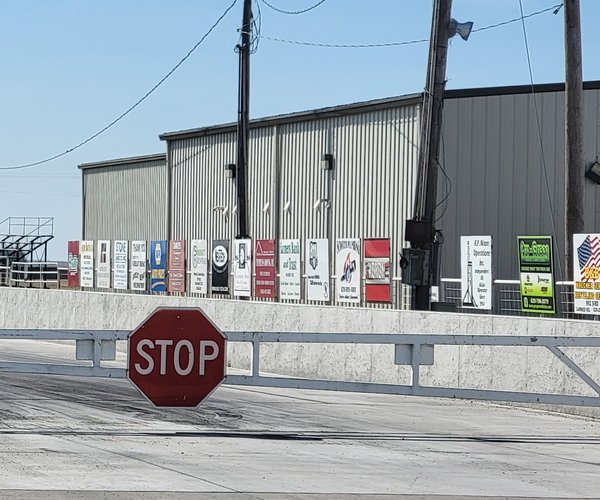When it comes to the recently discovered rough spots in the Sunflower Rod and Custom Association dragstrip, who knew what, when — and why weren’t Great Bend city officials and the city council kept in the loop?
These questions frustrated City Administrator Kendal Francis and angered council members Monday night as they grappled with what has been a costly problem.
“It has recently come to light that there are uneven patches in the recently finished racing surface on the newly reconstructed track,” Francis said. These were severe enough that they prevented the track from being used for racing.
So, to salvage the SRCA’s season, Francis authorized SRCA to hire a firm to fix the problem area at an estimated cost of $72,000. In the meantime, he said the city will assess who was at fault and how the extra costs will be paid.
In July 2020, the council approved a bid from Suchy Construction of Great Bend for $1,601,206.54 for a full-depth replacement of the entire track at the Great Bend Expo Complex west of town. This was part of the Kansas Department of Transportation Cost Share program, along with work on 10th Street which dated back to 2019.
The first races on the new track were months ago.
The crux of the issue is that SRCA failed to notify the city administration until July 21 that there was a problem, and that SRCA had already racked up considerable expenses to fix it.
Upon completion of the project earlier this summer, SRCA found several ”high spots” existed in the racing surface that caused dragsters to shake and their wheels to leave the track, Francis said.
Aaron and Rick Suchy, representing Suchy Construction, and Joel Krosschell, with Evans, Bierly, Hutchison and Associates Consulting Engineers of Great Bend (which handled the engineering for the project), were present for the meeting. They were grilled extensively by council members who wanted to know why the city wasn’t informed before any work was done.
The city owns the dragstrip and the contract to restore it was with the city.
“At the end of the day, it was bad communication on Aarons’s part and on the dragstrip’s part because neither one of them had proper authority to make the decisions without any of us knowing,” Mayor Cody Schmidt said.
Schmidt said he and the city staff were assured that all this extra work won’t damage the new track. Engineers indicated it could easily last 30 years.
Communication breakdown
“You’ve got a good product and you got a good price on it,” Krosschell said of project. After it was done, EBH checked the profile of the track and it did show some spots that needed correction.
EBH recommended bringing in a grinder, but Krosschell said SRCA offered to use their grinder since they had their first race looming. However, it was clear after that race that the work done by SRCA was not sufficient.
For context, the specifications called for there to be no more than an eighth of an inch variation over 12 feet. Ideally, it should be closer to 20-50 feet.
“I think it’s in our best interest to explain how we ended up where we ended up,” Aaron Suchy said. “A lot of this did happen just because we wanted to move very quickly so they did not miss any races.”
SRCA’s grinder wouldn’t touch the hardened concrete. So a grinder had to be brought in at a cost of $6,000 per day.
After that, they had to hire a company, Total Venue Concepts, to professionally polish the concrete racing surface for $72,000.
“We probably should have come back in the council and said ‘hey, we’re within spec, but what do you want us to do now, because (SRCA President Hank Denning) is still not comfortable,” he said. “We were working just straight with him. We kind of felt like ultimately he’s the one that’s got to be happy when this is done, because he’s the one running the deal.”
They also felt hurried since SRCA has its big Lucas Oil Series races coming in this weekend.
“So I guess I’m a little confused,” Ward 2 Councilwoman Jolene Biggs said. “Your contract is with the city, so why would you not have worked with the city more, even though Hank is very knowledgeable. Why would you not have kept the architect nor the city in the loop to know what was going on?”
Suchy agreed they probably should have consulted the city or Krosschell first. “In hindsight, that’s what we should have done.”
Now, after the polishing, the track needs to be tested again to see if it is within specifications, Krosschell said.
Biggs said she understood the importance of getting the track to spec. Otherwise, there could be a danger for drivers and a liability for the city.
Although the track has yet to be retested after the polishing, Krosschell said he’s confident it meets specifications.
This sort of work is not uncommon in projects like this, Krosschell said. “We knew there would be grinding. We anticipated that.”
But, “I’m just am a little discouraged,” Biggs said. “The contract was with Suchy Construction. And so, ultimately, it seems that somewhere along the way, somebody went rogue.”
“So, between Aaron and Joel and Hank, and everybody who’s not paid by The City of Great Bend, at what point did this finally come to Kendal, Cody or Scott (Public Lands Director Scott Keeler)?” Ward 3 Councilman Cory Urban said. “I guess I’m just having a hard time with the time line.”
City officials learned about this a little over a week ago, but the first race was over two months ago. “I’m extremely glad we haven’t had any cars flying off the road,” Urban said.
“I know a couple of racers that raced out there and they were extremely embarrassed with how it was,” Urban said. “It’s been repaired now, but this all could have been avoided if it had been attacked head-on earlier, even if a couple of races had to be canceled.”
The council was assured that “substantial completion” of the track was done by the contract deadline. In addition to the testing, some dirt grading remains to be done.
Figuring out the funding
“Cody (Schmidt) and I visited and said we couldn’t spend the $1.2 million and then not finish it and not be able to use it,” Francis said. “So, essentially I told Hank (Denning) to go forward and get the polisher here because it was a very tight window, and then we would figure out the financial portion of it.”
The city recently provided a $160,000, 10-year, interest-free loan to the SRCA to build permanent protective retaining walls on the outside edges of the race lanes and to upgrade their electronic timing system. The city covered the entirety of the cost of the $274,320.78 project (with two bills outstanding) with the expectation that SRCA would reimburse the city up to the loan amount.
This work has cost about $120,000 above the amount of the loan, Francis said. SRCA still owes the city for this overage, but spent its money on the grinding and polishing.
SRCA doesn’t have the funds to pay off the polishing and finish off the loan, he said.
“We are exploring some additional state funding to help cover the additional costs,” Francis said. “But as of this moment, nothing has come to fruition.”
“I think the key is that it needs to be at the best that it can be, and it sounds like that’s what you guys have done,” Biggs said.
The dragstrip was one of two cost-share projects totalling over $3 million, the other being the milling and overlaying of much of 10th Street through Great Bend. KDOT covered 75% of the cost of both.





